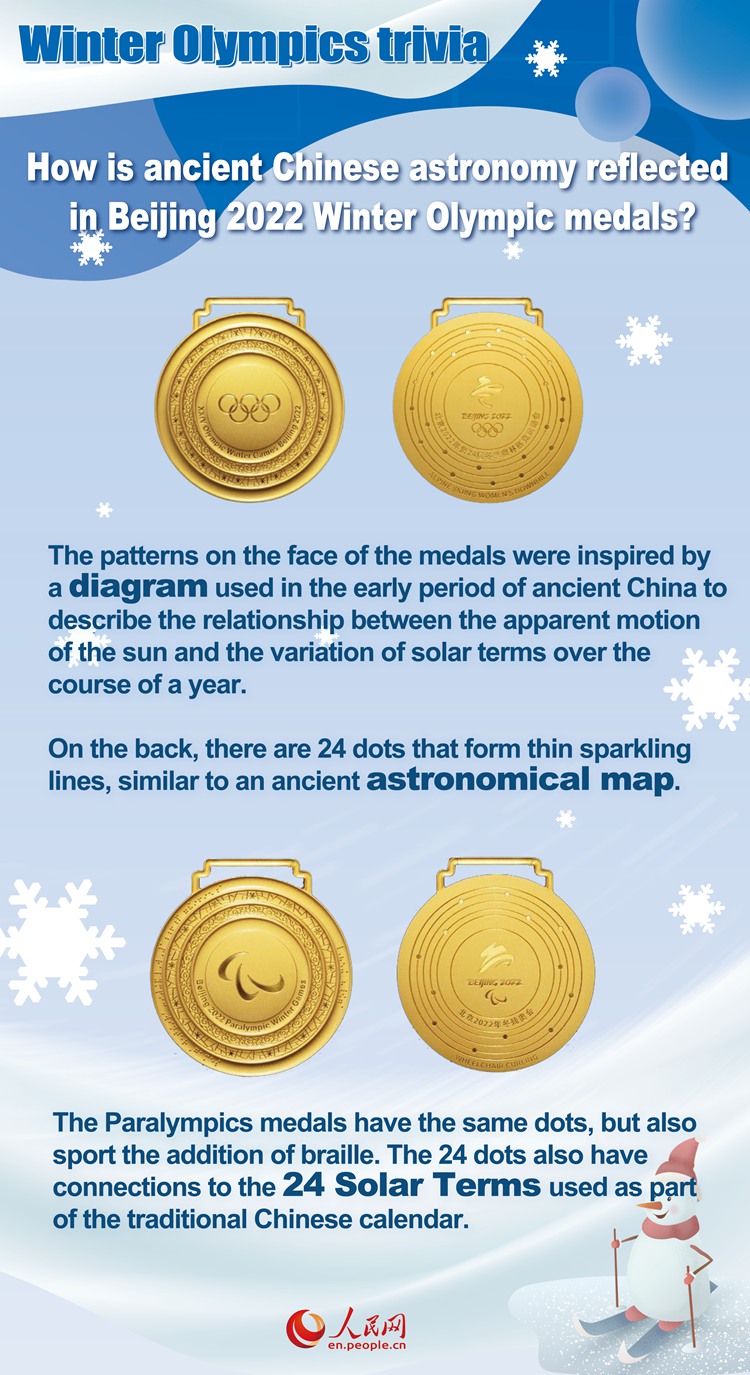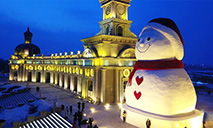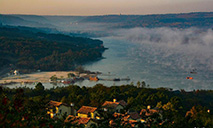Winter Olympics trivia: How is ancient Chinese astronomy reflected in Beijing 2022 Winter Olympic medals?

The medal designs for the upcoming 2022 Beijing Olympic and Paralympics Winter Games were inspired by ancient Chinese astronomy, according to the design team.
The medals are composed of rings and a center, based on the ancient Chinese jade concentric circle pendants. On the back, there are also 24 dots engraved on the rings, similar to an ancient astronomical map. This symbolizes the vast starry sky, the harmony between humans and nature and the ambitions of athletes to reach the very peak of their performance during the Games.
According to the design team, a diagram recorded in the book titled Zhoubi Suanjing, the Zhou Dynasty Classic of the Gnomon, has contributed to the patterns used on the medals.
The diagram is mainly used to describe the relationship between the apparent motion of the sun and the variation of solar terms over the course of a year, and to reveal the origin between astronomy and the calendar. It is a theory about the structure of the universe in the early period of ancient China.
The diagram consists of seven concentric circles, each of which is a "Heng." Each "Heng" represents the trajectory of the sun for each seasonal variation over the course of a year.
On the diagram, the outermost circle with the largest radius is the outer "Heng," when the solar orbit is farthest from the observation point, which indicates the Winter Solstice. The innermost circle with the smallest radius is the inner "Heng" – that is, when the solar orbit is closest to the observation point, which in turn indicates the Summer Solstice.
Moving from the "Heng" for the Winter Solstice to that of the Summer Solstice, the five "Heng" in the middle represent the solar orbits during the five solar terms of the Major Cold, Rain Water, the Spring Equinox, Grain Rain and Grain Buds, respectively.
Moving from the "Heng" for the Summer Solstice to that of the Winter Solstice, the five "Heng" in the middle represent the solar orbits during the five solar terms of the Major Heat, Minor Heat, Autumn Equinox, Frost's Descent and Minor Snow, respectively. Shifting from external "Heng" to internal "Heng," and then from internal "Heng" to external "Heng," the two stages are divided into 12 equal parts respectively, which adds up to 24 solar terms.
The ancient Chinese people believed that the sun revolved around the polar axis once a day, forming day and night. They connected the apparent path of the sun between different "Heng" in a year to form the "ecliptic." They divide the ecliptic into 24 equal parts, which also equal to 24 solar terms.
Meanwhile, there is a corresponding relationship between the ancient Chinese astronomic knowledge described in the diagram and the five zones divided on the earth, including the Tropics, the South Temperate Zone, the North Temperate Zone, the South Frigid Zone and the North Frigid Zone, in which the inner "Heng" corresponds to the Tropic of Cancer, the middle "Heng" corresponds to the equator, and the outer "Heng" corresponds to the Tropic of Capricorn.
Related:
Winter Olympics trivia: What is the youngest of the seven major sports at the Winter Olympics?
Winter Olympics trivia: How many times has "ski ballet" appeared at previous Winter Olympic Games?
Winter Olympics trivia: How important are meteorological services for the Winter Olympics?
Winter Olympics trivia: What kinds of robots will serve the Beijing 2022 Winter Olympics?
Winter Olympics trivia: Is coldest always best when selecting a site for the Winter Olympic Games?
Winter Olympics trivia: Why is the Zhangjiakou Winter Olympic Village composed of courtyards?
Winter Olympics trivia: How fast are bobsleighs – the "Formula One on ice"?
Winter Olympics trivia: What are the new events for Beijing 2022 Winter Games?
Photos
Related Stories
- Welcome to Xiongan Winter Olympic Cultural Square
- Western groups step up disinformation efforts as Beijing Winter Olympics approaches
- Ski jumping platform in Beijing busy with snowmaking for 2022 Winter Olympic Games
- Gold, silver commemorative bars for Beijing 2022 Winter Olympics launched
- Shining moments in China's Winter Olympic Games history
Copyright © 2022 People's Daily Online. All Rights Reserved.










